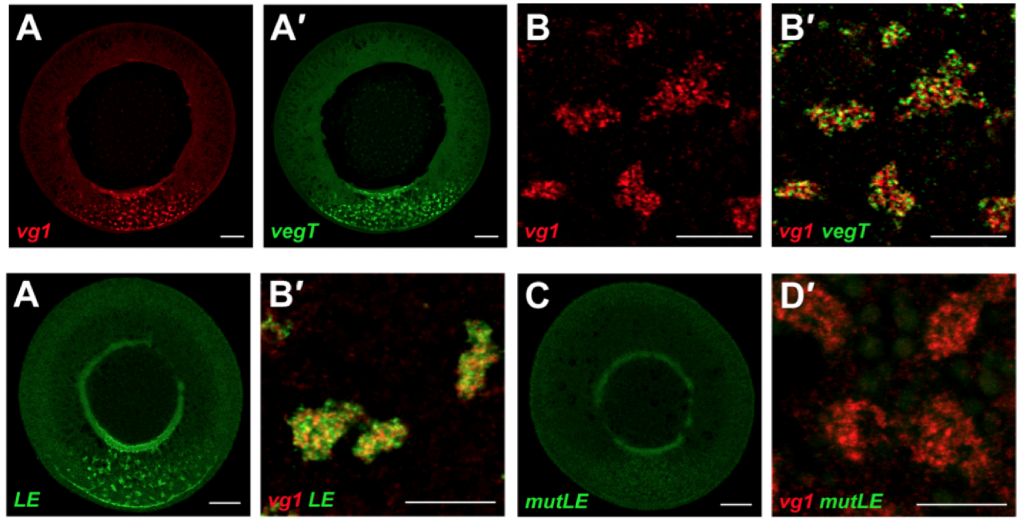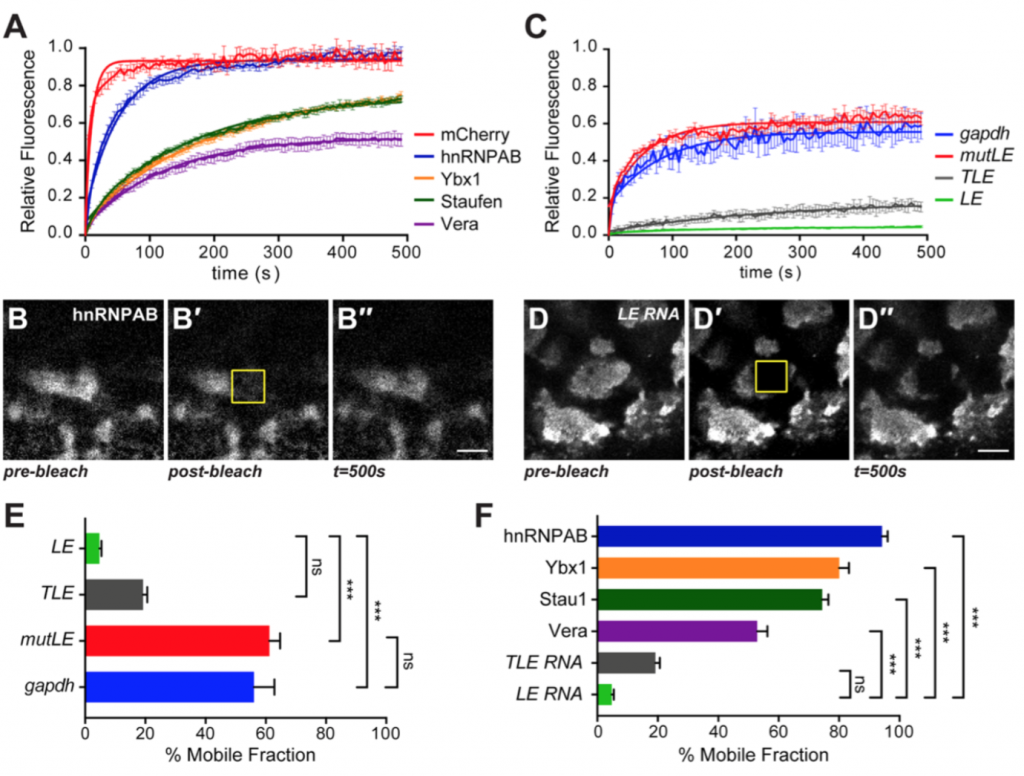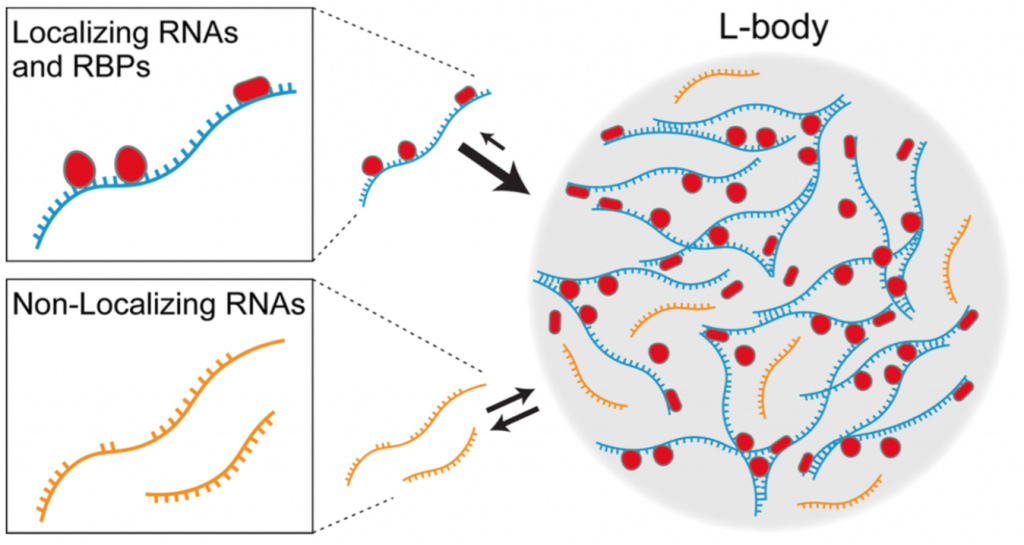L-bodies are novel RNA-protein condensates driving RNA transport in Xenopus oocytes
Posted on: 28 May 2020 , updated on: 29 May 2020
Preprint posted on 10 May 2020
Article now published in Molecular Biology of the Cell at http://dx.doi.org/10.1091/mbc.E21-03-0146-T
Joining the phase separated party: Oocytes have multiphasic Localization bodies
Selected by Maiko KitaokaCategories: cell biology
Background: Phase separated bodies are all the rage to localize RNAs
Recently, there’s been a burst of new discoveries around cellular phase separated bodies as translational hubs, a way to spatially organize the cell’s cytoplasm. These foci, called ribonucleoprotein (RNP) granules, take advantage of RNA and protein binding features to collect the relevant biomolecules into the granule. In addition to their unique biophysical properties as liquid-like phase separated droplets, RNP granules also serve a biological function to regulate mRNA localization and distribution throughout the cytoplasm in order to generate cellular asymmetry and polarity that benefits cellular function. However, it’s unclear how these combinations of RNAs, proteins, and other elements may form RNPs and mediate their physical nature.
That’s where the Xenopus oocyte comes in handy. mRNAs must be localized in developing oocytes to pattern the embryo after fertilization, and these are specifically transported to the bottom of the oocyte, called the vegetal pole. These specific mRNAs rely on their RNA binding proteins (RBPs) to create an RNP structure that can be transported by microtubule motors down to the vegetal pole. Neil and Jeschonek et al have looked into the process more carefully to discover Localization bodies (L-bodies), which contain these RNP granule components and turn out to be multiphasic based on the biomolecular identities of L-body components. They unveil a new organization for cytoplasmic granules, opening new doors for investigation into their function in oocyte biology.
Key findings: It’s all about localization signals
Key mRNAs encoding germ layer formation, such as vg1, vegT, and trim36, are well known to localize to the vegetal pole in Xenopus oocytes via interactions with their RBPs. They appear in large clusters at the vegetal oocyte cytoplasm, enriched with multiple foci of each vegetal mRNA and its associated RBP, while other non-localized RNAs such as gapdh are not specifically enriched though included in the cluster. The composition of these clusters identified them as RNP granules, so the authors call these structures Localization bodies, or L-bodies.
L-bodies are encased in microtubule baskets with both kinesin and dynein motors, in line with previous observations that vegetal mRNAs are transported in a microtubule motor-dependent fashion. The microtubule baskets suggest that the L-bodies, rather than individual mRNAs, are interacting with this transport machinery.
Importantly, mRNA localization signals provide specificity for L-body composition. The authors microinjected a short RNA that recapitulates the vegetal localization of vg1, demonstrating that it can be packaged into L-bodies with endogenous vg1. However, if a mutant version that lacks RBP binding (mutLE) is microinjected, the RNA is not localized to the vegetal pole and is not incorporated into L-bodies. Thus, enrichment into L-bodies is mediated by sequence-specific features of target RNAs, which is then required for subsequent vegetal localization.

The authors then biochemically purified L-bodies and used mass spectrometry to identify candidate proteins. They found 86 L-body protein components, including all known RBPs, dynein, and kinesin. Excitingly, they found novel components that may provide functional specificity to L-bodies, but they also discovered that the proteome is filled with proteins that have been identified in other types of cytoplasmic granules, furthering their connection to previous studies of RNP granules. The majority of proteins have intrinsically disordered regions, and prion-like domains in particular are overrepresented in L-bodies.
Interestingly, thioflavin staining revealed a mesh-like structure in L-bodies, indicative of a more gel- or solid-like state, rather than liquid-like. This also fits in neatly with the overrepresentation of prion-like domains, which tend to lead to gel- or amyloid-like properties. Ex vivo, L-bodies are insensitive to hexanediol, suggesting that they are not liquid-like at all.
This hypothesis led the authors to perform FRAP experiments to probe the dynamic properties of L-bodies, and this led to an intriguing discovery. L-body proteins are dynamic and recover quickly after photobleaching, but localized RNAs are relatively immobile. Non-localized RNAs, such as gapdh or mutLE, are dynamic, similar to proteins. This suggests that L-bodies are multiphasic, where the important localized RNAs are immobile and create a gel-like center, while proteins are more dynamic and envelope this structure.

The authors propose a model where the localized RNAs are an organizational scaffold, and the interactions with specific RBPs promote local enrichment and incorporation of mRNAs into L-bodies. High RNA concentration promotes more RNA/RNA interactions, thus forming a solid gel like state and creating multiphasic behavior. Proteins can become more enriched with the RNA scaffold, but non-localized RNAs lack the ability to interact with the original scaffold, so they freely diffuse in and out. These new insights into mRNA localization through multiphasic L-bodies leads to interesting hypotheses about their function in oocytes and how they may mediate oocyte biology, including a role in packaging maternal material and silencing translation for very long periods of time.

Questions for the authors
How are L-bodies spaced throughout the cytoplasm? The images of the microtubule basket make it seem like L-bodies are connected to each other via the microtubule network as well. Apart from the role in transporting L-bodies, could the microtubules help to space out the bodies to maintain local foci rather than coalescing into a very large single L-body?
Do the novel proteins found in the L-body proteome provide any hints to their specific role in oocytes, especially since they are not found in other types of cytoplasmic granules? Relatedly, are specific families/classes of protein functions enriched in the proteome (rather than overrepresented domains)?
The role of L-bodies in oocytes in particularly intriguing to speculate on. For example, what would happen if L-bodies were disrupted after migration to the vegetal pole? How might that affect development/patterning/translation in the oocyte?
doi: https://doi.org/10.1242/prelights.21239
Read preprintSign up to customise the site to your preferences and to receive alerts
Register hereAlso in the cell biology category:
Cell cycle-dependent mRNA localization in P-bodies
Mohammed JALLOH
Control of Inflammatory Response by Tissue Microenvironment
Roberto Amadio
Notch3 is a genetic modifier of NODAL signalling for patterning asymmetry during mouse heart looping
Bhaval Parmar
preLists in the cell biology category:
BSCB-Biochemical Society 2024 Cell Migration meeting
This preList features preprints that were discussed and presented during the BSCB-Biochemical Society 2024 Cell Migration meeting in Birmingham, UK in April 2024. Kindly put together by Sara Morais da Silva, Reviews Editor at Journal of Cell Science.
| List by | Reinier Prosee |
‘In preprints’ from Development 2022-2023
A list of the preprints featured in Development's 'In preprints' articles between 2022-2023
| List by | Alex Eve, Katherine Brown |
preLights peer support – preprints of interest
This is a preprint repository to organise the preprints and preLights covered through the 'preLights peer support' initiative.
| List by | preLights peer support |
The Society for Developmental Biology 82nd Annual Meeting
This preList is made up of the preprints discussed during the Society for Developmental Biology 82nd Annual Meeting that took place in Chicago in July 2023.
| List by | Joyce Yu, Katherine Brown |
CSHL 87th Symposium: Stem Cells
Preprints mentioned by speakers at the #CSHLsymp23
| List by | Alex Eve |
Journal of Cell Science meeting ‘Imaging Cell Dynamics’
This preList highlights the preprints discussed at the JCS meeting 'Imaging Cell Dynamics'. The meeting was held from 14 - 17 May 2023 in Lisbon, Portugal and was organised by Erika Holzbaur, Jennifer Lippincott-Schwartz, Rob Parton and Michael Way.
| List by | Helen Zenner |
9th International Symposium on the Biology of Vertebrate Sex Determination
This preList contains preprints discussed during the 9th International Symposium on the Biology of Vertebrate Sex Determination. This conference was held in Kona, Hawaii from April 17th to 21st 2023.
| List by | Martin Estermann |
Alumni picks – preLights 5th Birthday
This preList contains preprints that were picked and highlighted by preLights Alumni - an initiative that was set up to mark preLights 5th birthday. More entries will follow throughout February and March 2023.
| List by | Sergio Menchero et al. |
CellBio 2022 – An ASCB/EMBO Meeting
This preLists features preprints that were discussed and presented during the CellBio 2022 meeting in Washington, DC in December 2022.
| List by | Nadja Hümpfer et al. |
Fibroblasts
The advances in fibroblast biology preList explores the recent discoveries and preprints of the fibroblast world. Get ready to immerse yourself with this list created for fibroblasts aficionados and lovers, and beyond. Here, my goal is to include preprints of fibroblast biology, heterogeneity, fate, extracellular matrix, behavior, topography, single-cell atlases, spatial transcriptomics, and their matrix!
| List by | Osvaldo Contreras |
EMBL Synthetic Morphogenesis: From Gene Circuits to Tissue Architecture (2021)
A list of preprints mentioned at the #EESmorphoG virtual meeting in 2021.
| List by | Alex Eve |
FENS 2020
A collection of preprints presented during the virtual meeting of the Federation of European Neuroscience Societies (FENS) in 2020
| List by | Ana Dorrego-Rivas |
Planar Cell Polarity – PCP
This preList contains preprints about the latest findings on Planar Cell Polarity (PCP) in various model organisms at the molecular, cellular and tissue levels.
| List by | Ana Dorrego-Rivas |
BioMalPar XVI: Biology and Pathology of the Malaria Parasite
[under construction] Preprints presented at the (fully virtual) EMBL BioMalPar XVI, 17-18 May 2020 #emblmalaria
| List by | Dey Lab, Samantha Seah |
1
Cell Polarity
Recent research from the field of cell polarity is summarized in this list of preprints. It comprises of studies focusing on various forms of cell polarity ranging from epithelial polarity, planar cell polarity to front-to-rear polarity.
| List by | Yamini Ravichandran |
TAGC 2020
Preprints recently presented at the virtual Allied Genetics Conference, April 22-26, 2020. #TAGC20
| List by | Maiko Kitaoka et al. |
3D Gastruloids
A curated list of preprints related to Gastruloids (in vitro models of early development obtained by 3D aggregation of embryonic cells). Updated until July 2021.
| List by | Paul Gerald L. Sanchez and Stefano Vianello |
ECFG15 – Fungal biology
Preprints presented at 15th European Conference on Fungal Genetics 17-20 February 2020 Rome
| List by | Hiral Shah |
ASCB EMBO Annual Meeting 2019
A collection of preprints presented at the 2019 ASCB EMBO Meeting in Washington, DC (December 7-11)
| List by | Madhuja Samaddar et al. |
EMBL Seeing is Believing – Imaging the Molecular Processes of Life
Preprints discussed at the 2019 edition of Seeing is Believing, at EMBL Heidelberg from the 9th-12th October 2019
| List by | Dey Lab |
Autophagy
Preprints on autophagy and lysosomal degradation and its role in neurodegeneration and disease. Includes molecular mechanisms, upstream signalling and regulation as well as studies on pharmaceutical interventions to upregulate the process.
| List by | Sandra Malmgren Hill |
Lung Disease and Regeneration
This preprint list compiles highlights from the field of lung biology.
| List by | Rob Hynds |
Cellular metabolism
A curated list of preprints related to cellular metabolism at Biorxiv by Pablo Ranea Robles from the Prelights community. Special interest on lipid metabolism, peroxisomes and mitochondria.
| List by | Pablo Ranea Robles |
BSCB/BSDB Annual Meeting 2019
Preprints presented at the BSCB/BSDB Annual Meeting 2019
| List by | Dey Lab |
MitoList
This list of preprints is focused on work expanding our knowledge on mitochondria in any organism, tissue or cell type, from the normal biology to the pathology.
| List by | Sandra Franco Iborra |
Biophysical Society Annual Meeting 2019
Few of the preprints that were discussed in the recent BPS annual meeting at Baltimore, USA
| List by | Joseph Jose Thottacherry |
ASCB/EMBO Annual Meeting 2018
This list relates to preprints that were discussed at the recent ASCB conference.
| List by | Dey Lab, Amanda Haage |











 (No Ratings Yet)
(No Ratings Yet)